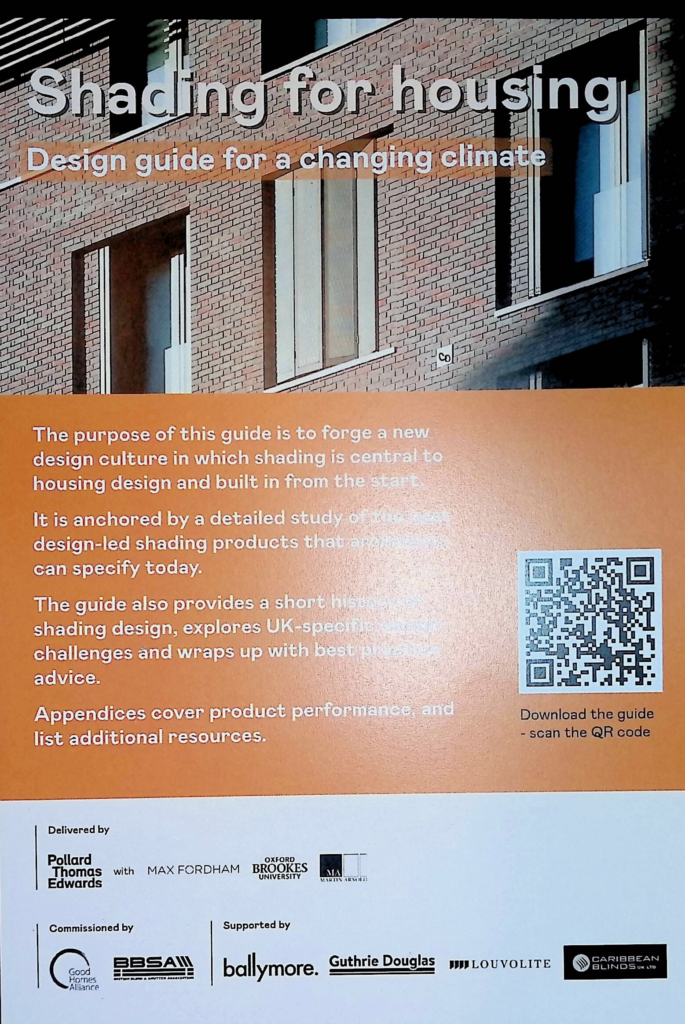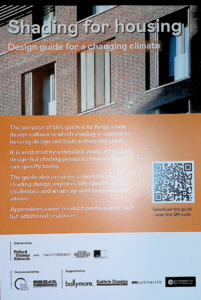
GHA Shading for Housing (Book)
GBE > Encyclopaedia > Design > Information > Book > G#41142
About:
GBE Editorial Comment
See notes at end of this column.
The Good Homes Alliance (GHA) and the British Blind and Shutter Association (BBSA) have launched a new design guide on shading for housing, seeking to embed a new culture – among building makers of all stripes – in which shading is central to a building’s design and built-in from the start.
The work has been led by an experienced team at award-winning architect Pollard Thomas Edwards (PTE), including sustainability lead Tom Dollard, author of ‘Designed to Perform’, Passivhaus designer Joseba Perez, and sustainable design specialist Raffaella Corrieri.
The guide was launched at a popular in-person event on 9th November at PTE’s offices at Diespeker Wharf in London, with talks from the wider project team which includes renowned engineering firm Max Fordham; Rajat Gupta, Professor of Sustainable Architecture and Climate Change at Oxford Brookes University, and construction consultants, Martin Arnold.
Who has supported the guide?
Development of the guide has been supported by:
- Ballymore – See case studies
- Caribbean Blinds – See image gallery
- Guthrie Douglas – See project gallery
- Louvolite – See style blog
A steering group* of industry experts and stakeholders from across the sector has supported the development of the guide, with representatives from Architype, Greater Cambridge Shared Planning Service, CIBSE, ECD Architects, NDM Heath, OX Place, Sovereign, TOWN and Urban Light Surveyors.
Why is the guide needed? Future proofing and climate resilience
As global temperatures continue to rise, so does the risk of buildings overheating. A recent study1 shows that by the middle of the 2030s, 90% of the UK housing stock will suffer from overheating. Simply put, our built environment – designed for dampness, breeze, rain and mild heat – is in no fit state to shelter us from this changing climate.
Currently in the UK, buildings are not required to pass the overheating criteria using future weather files to comply with the Building Regulations. Modelling using predicted future weather data has shown that buildings designed with shading products built-in from the start are less likely to overheat in the future than those that aren’t.
“Since 2014, when Good Homes Alliance published ‘Preventing Overheating’ an evidence-based report on overheating and mitigation, we have worked on guidance and tools to mitigate overheating in homes. In 2019, we launched our tool and guidance to identify and mitigate overheating risks for new homes, followed by a version for retrofit and existing homes in 2022.
This latest guidance expands on applicable strategies, seeking to influence decision making at an early stage, and provide the industry with the tools and knowledge to identify and integrate shading solutions as part of a holistic approach to resilience and aesthetics appropriate for our climate challenge.”
Lynne Sullivan OBE, Chair, Good Homes Alliance
This guide calls for a new design culture in the UK. A design culture in which the everyday specification of shading products on domestic buildings – or the designing for shading from the start – is second nature among developers, housebuilders, architects and consultants.
The public too, buyers and tenants alike, should be well-versed in the benefits that shading products bring, in terms of reduced running costs, improved comfort and general wellbeing. The guide provides a shading ‘cheat sheet’ focused on the practicalities of adapting to holistic shading design.
Embodied carbon of shading products‘
What is in the guide?
A product section provides detailed information to help users to select the right product for a building’s shading needs. Each product page features a brief description, a table detailing its functionality, an in-situ product photograph, a ‘performance web’ visualising a product’s strengths and weaknesses and, where relevant, an architect’s comment on a product’s added value.
The guide also provides a short history of shading design, explores UK-specific design challenges and wraps up with best practice advice.
The guidance is applicable to both new build and retrofit projects, and aimed at a range of stakeholders including architects, local authorities, planners, housing associations, developers, and policy makers.
* Full steering group list: Andrew Chalk, British Blind and Shutter Association; Dave Bush, British Blind and Shutter Association; Zoe de Grussa, British Blind and Shutter Association; Richard Broad, Good Homes Alliance; Julian Brooks, Good Homes Alliance; Rajat Gupta, Oxford Brookes University; Chris Martin, Martin Arnold; Anastasia Mylona, The Chartered Institution of Building Services Engineers (CIBSE); Belen Alemany, Energy Conscious Design Architects (ECD); Debbie Haynes, OX Place; Emma Davies, Greater Cambridge Shared Planning Service; Nicholas Heath, NDM Heath; Gregory Francis, Urban Light Surveyors; Adrian Coe, Urban Light Surveyors; Richard Young, Sovereign; Steve Birtles, Louvolite; Stuart Dantzic, Caribbean Blinds; Andy Kitching, Guthrie Douglas; Aaron Caffrey, Ballymore; Bryn Marler, Ballymore; Neil Murphy, TOWN; Seb Laan Lomas, Architype.
ARUP, Addressing overheating risk in existing UK homes (2022) An Arup report commissioned by the Climate Change Committee; retrieved online September 2023.
For more information about the project, please contact Richard Broad, Projects Manager, Good Homes Alliance – richard@goodhomes.org.uk.
Get involved with the GHA
Thinking of joining or recently joined GHA? Visit our Member Hub to find out the benefits of membership.
Visit our Knowledge Base for 100+ resources and member-only content such as webinar recordings.
GBE Editorial Comment
A good step in the right direction, its is hoped that these will inspire many more installations and innovative approaches.
Zero Carbon Hub published information on overheating and reported 20% of housing overheats already.
Southern and Western rooms suffered most, upper floors suffer more than intermediate or lower floors.
It is reported that 90% of housing will be overheating by mid 2030’s
Zero Carbon Hub understood that solar gains through windows needs to be addressed.
Zero Carbon Hub failed to understand solar gains through lightweight opaque building fabric (walls and roofs) also needs to be addressed.
Heavyweight wall construction using masonry, concrete, Cob, CobBauge, Rammed Earth, Hemp-lime, etc. offer substantial protection from solar heat gains,
Lightweight wall construction using light timber frame, light steel frame with glass or stone wool or plastic insulation offers little or no solar overheating protection.
Lightweight roof construction including timber frame, metal frame with clay, stone or concrete roof tiles do not offer protection from solar heat gains.
Lightweight wall construction using brick slips does not offer solar heat gain protection.
Rainscreen cladding could off some protection but needs lots of ventilation of the air space behind.
Building Integrated PV panels offer no solar protection since the heat in the PV reradiates heat inwards.
PV on framing above the roof surface offers some solar protection if wind is dispersing the heat from their underside.
Warehouse buildings usually use wrinkly tin roofs and wall cladding with stone wool insulation to control fire spread, they will solar hear gain overheat easily and cold food storage uses energy intensive air conditioning to stay cool.
We need to consider solar shading above roofs, rooflights, roof windows, outside of lightweight construction.
- External Solar shading on glass facades is probably essential,
- But probably creates thermal bridges through that façade.
- Solar protective coatings on glass are the poor man’s answer to solar shading,
- But probably is not cheap.
- Is better than nothing.
- Solar shading can also be about controlling reflection from a façade
- Especially curved surfaces that concentrate reflected light
- Rafael Vinoley’s ‘Walkie Scorchie’ tower melted stuff on the opposite side of road
© GBE GBC GRC GBL NGS ASWS Brian Murphy aka BrianSpecMan ****
11th November 2023 – 13th November 2023
Images:

Flyer

QR code to download
- Online Book > PDF
- _ PDF on GBE
© GBE GBC GRC GBL NGS ASWS Brian Murphy aka BrianSpecMan ****
11th November 2023
See Also:
GBE Issues
- Indoor Air Quality IAQ (Issue) G#1119 N#1135
- Overheating (Issue Paper) G#145
GBE Books
- A Guide to Designing Healthy Homes (Book) G#23709
- Good Practice In the Design of Homes TM60 CIBSE (Book) G#19212
- Designed to Perform (Book) G#17003 An Illustrated Guide to Delivering Energy Efficient Home
- Low Impact Building Housing using Renewable Materials (Book) G#1326 N#1314
- Environmental Design Pocket Book 2nd edition (Book) G#1327 N#1315
- Environmental Design Pocket Book 1st edition (Book) G#534 N#554
- Building with Reclaimed Components & Materials (Book) G#1329 N#1317
- Full Product Transparency (FPT) (Book) G#765 N#787
GBE Projects
- Designed to Perform (Book) G#17003 An Illustrated Guide to Delivering Energy Efficient Home
- Environmental Design Pocket Book 2nd edition (Book) G#1327 N#1315
- Environmental Design Pocket Book 1st edition (Book) G#534 N#554
- BioDiversity and Zero Carbon Buildings Book
- Designing for Biodiversity: A technical guide for new and existing buildings (Book) G#535 N#555
- Hemp-lime project
- Buro Happold Guide to Reclaim Reuse & Recycling (Book) G#545
- Building with Reclaimed Components & Materials (Book) G#1329 N#1317
- Envirowise Packaging waste guide (Book) G#547
- AECB Carbon Lite (Programme)
- TSB RetroFit for a Future Competition
GBE Information
- SEDA have published a 4 guides
- https://www.seda.uk.net/design-guides
- Design and Detailing for Airtightness
- Design and Detailing for Toxic Chemical Reduction in Buildings
- Improving Homes for energy, health and environment Sustainable renovation
- Design and Detailing for Deconstruction
GBE Other’s Reports
- Net Zero Carbon UK 2050 (Advisory Report) G#25511
- Barbour Report 2000 Influencing Product Decisions G#12473
- Horizon 2020 Special Reports (News) G#62
GBE CPD
- GBE L15 External Solar Shading (CPD) G#41122
- GBE L15 Alternative External Solar Shading (CPD) G#41115
GBE Outline
- GBE L15 External Solar Shading (Outline) G#41109
GBE Webinars
- Primitive Materials Future Building (Webinar) G#16202
GBE Materials
GBE Survey
GBE Jargon Buster
GBE Question + Answer
GBE Checklist
- Decent Homes (Checklist) G#1571 N#1507
- Refurbishment Decent Homes (Checklist) G#1253 N#1252
- Green Deal Refurbishment (Checklist) G#730 N#752
- Other issues (Checklist) G#1570 N#1506
- GBE New Build Checklist (Navigation) G#606 N#627
- A90 Performance Specification (Checklist) G#1715 N#1617
- A91 Prescriptive Specification (Checklist)
- A93 Performance Testing Off-site Mock-up Test rigs (Checklist) G#1719 N#1621
- A94 Airtightness testing on-site (Checklist) G#1720 N#1622
- A95 Infra-Red Thermographic Surveys (Checklist) G#1721 N#1623
- G Structural/ Carcassing metal/ timber (Checklist) G#1596 N#1526
- G20 Carpentry Timber Framing First Fixing (Checklist) G#1597 N#1527
- H Claddings Coverings (Checklist) G#1735 N#1635
- H21 Timber Weatherboarding (Checklist) G#11946
- L10 Windows (Checklist) G#1605 N#1534
- L10 Windows Rooflights Screens Louvres (Checklist) G#1604 N#1533
- Z10 Purpose Made Joinery (Checklist) G#1593 N#1524
- Z34 Hot Dip Galvanizing (Checklist) G#1879 N#174
© GBE GBC GRC GBL NGS ASWS Brian Murphy aka BrianSpecMan ****
11th November 2023 – 13th November 2023

